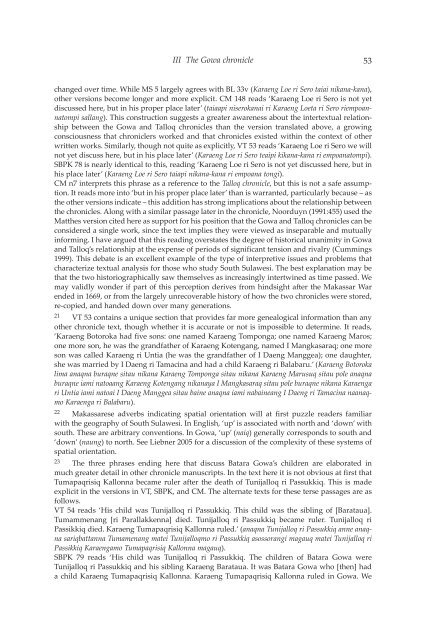A CHAIN OF KINGS - Books and Journals
A CHAIN OF KINGS - Books and Journals
A CHAIN OF KINGS - Books and Journals
You also want an ePaper? Increase the reach of your titles
YUMPU automatically turns print PDFs into web optimized ePapers that Google loves.
III The Gowa chronicle 53<br />
changed over time. While MS 5 largely agrees with BL 33v (Karaeng Loe ri Sero taiai nikana-kana),<br />
other versions become longer <strong>and</strong> more explicit. CM 148 reads ‘Karaeng Loe ri Sero is not yet<br />
discussed here, but in his proper place later’ (taiaapi niserokanai ri Karaeng Loeta ri Sero riempoannatompi<br />
sallang). This construction suggests a greater awareness about the intertextual relationship<br />
between the Gowa <strong>and</strong> Talloq chronicles than the version translated above, a growing<br />
consciousness that chroniclers worked <strong>and</strong> that chronicles existed within the context of other<br />
written works. Similarly, though not quite as explicitly, VT 53 reads ‘Karaeng Loe ri Sero we will<br />
not yet discuss here, but in his place later’ (Karaeng Loe ri Sero teaipi kikana-kana ri empoanatompi).<br />
SBPK 78 is nearly identical to this, reading ‘Karaeng Loe ri Sero is not yet discussed here, but in<br />
his place later’ (Karaeng Loe ri Sero taiapi nikana-kana ri empoana tongi).<br />
CM n7 interprets this phrase as a reference to the Talloq chronicle, but this is not a safe assumption.<br />
It reads more into ‘but in his proper place later’ than is warranted, particularly because ‒ as<br />
the other versions indicate ‒ this addition has strong implications about the relationship between<br />
the chronicles. Along with a similar passage later in the chronicle, Noorduyn (1991:455) used the<br />
Matthes version cited here as support for his position that the Gowa <strong>and</strong> Talloq chronicles can be<br />
considered a single work, since the text implies they were viewed as inseparable <strong>and</strong> mutually<br />
informing. I have argued that this reading overstates the degree of historical unanimity in Gowa<br />
<strong>and</strong> Talloq’s relationship at the expense of periods of significant tension <strong>and</strong> rivalry (Cummings<br />
1999). This debate is an excellent example of the type of interpretive issues <strong>and</strong> problems that<br />
characterize textual analysis for those who study South Sulawesi. The best explanation may be<br />
that the two historiographically saw themselves as increasingly intertwined as time passed. We<br />
may validly wonder if part of this perception derives from hindsight after the Makassar War<br />
ended in 1669, or from the largely unrecoverable history of how the two chronicles were stored,<br />
re-copied, <strong>and</strong> h<strong>and</strong>ed down over many generations.<br />
21 VT 53 contains a unique section that provides far more genealogical information than any<br />
other chronicle text, though whether it is accurate or not is impossible to determine. It reads,<br />
‘Karaeng Botoroka had five sons: one named Karaeng Tomponga; one named Karaeng Maros;<br />
one more son, he was the gr<strong>and</strong>father of Karaeng Kotengang, named I Mangkasaraq; one more<br />
son was called Karaeng ri Untia (he was the gr<strong>and</strong>father of I Daeng Manggea); one daughter,<br />
she was married by I Daeng ri Tamacina <strong>and</strong> had a child Karaeng ri Balabaru.’ (Karaeng Botoroka<br />
lima anaqna buraqne sitau nikana Karaeng Tomponga sitau nikana Karaeng Marusuq sitau pole anaqna<br />
buraqne iami natoaang Karaeng Kotengang nikanaya I Mangkasaraq sitau pole buraqne nikana Karaenga<br />
ri Untia iami natoai I Daeng Manggea sitau baine anaqna iami nabaineang I Daeng ri Tamacina naanaqmo<br />
Karaenga ri Balabaru).<br />
22 Makassarese adverbs indicating spatial orientation will at first puzzle readers familiar<br />
with the geography of South Sulawesi. In English, ‘up’ is associated with north <strong>and</strong> ‘down’ with<br />
south. These are arbitrary conventions. In Gowa, ‘up’ (naiq) generally corresponds to south <strong>and</strong><br />
‘down’ (naung) to north. See Liebner 2005 for a discussion of the complexity of these systems of<br />
spatial orientation.<br />
23 The three phrases ending here that discuss Batara Gowa’s children are elaborated in<br />
much greater detail in other chronicle manuscripts. In the text here it is not obvious at first that<br />
Tumapaqrisiq Kallonna became ruler after the death of Tunijalloq ri Passukkiq. This is made<br />
explicit in the versions in VT, SBPK, <strong>and</strong> CM. The alternate texts for these terse passages are as<br />
follows.<br />
VT 54 reads ‘His child was Tunijalloq ri Passukkiq. This child was the sibling of [Barataua].<br />
Tumammenang [ri Parallakkenna] died. Tunijalloq ri Passukkiq became ruler. Tunijalloq ri<br />
Passikkiq died. Karaeng Tumapaqrisiq Kallonna ruled.’ (anaqna Tunijalloq ri Passukkiq anne anaqna<br />
sariqbattanna Tumamenang matei Tunijalloqmo ri Passukkiq asossorangi magauq matei Tunijalloq ri<br />
Passikkiq Karaengamo Tumapaqrisiq Kallonna magauq).<br />
SBPK 79 reads ‘His child was Tunijalloq ri Passukkiq. The children of Batara Gowa were<br />
Tunijalloq ri Passukkiq <strong>and</strong> his sibling Karaeng Barataua. It was Batara Gowa who [then] had<br />
a child Karaeng Tumapaqrisiq Kallonna. Karaeng Tumapaqrisiq Kallonna ruled in Gowa. We









![Am HaSefer [Volk des Buches] - Books and Journals](https://img.yumpu.com/20648352/1/174x260/am-hasefer-volk-des-buches-books-and-journals.jpg?quality=85)







